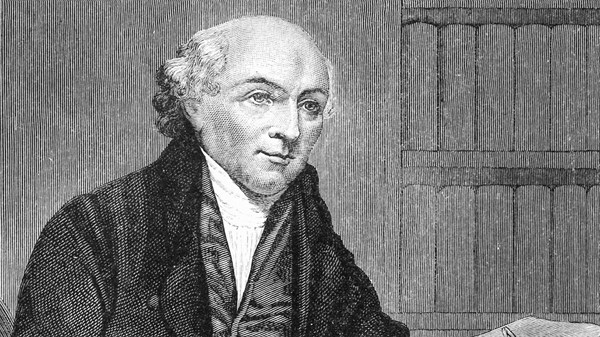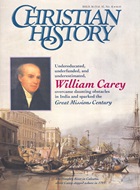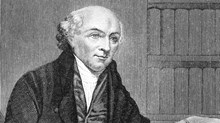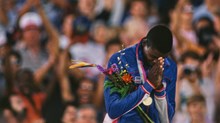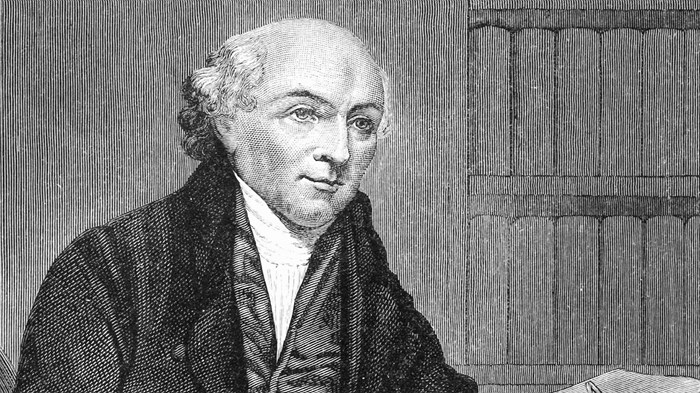
It was inconceivable that a poor, English cobbler would spend his Sunday this way. But it was not untypical of William Carey’s first year in India.
“In the morning and afternoon addressed my family,” he wrote in his diary in May 1794, “and in the evening began my work of publishing the Word of God to the heathen. Though imperfect in the knowledge of the language [Bengali], yet, with the help of moonshi [a translator], I conversed with two Brahmans in the presence of about two hundred people, about the things of God. I had been to see a temple, in which were the images of Dukkinroy, the god of the woods, riding on a tiger; Sheetulla, goddess of the small pox, without a head, riding on a horse without a head; Puchanon, with large ears .… I therefore discoursed with them upon … the folly and wickedness of idolatry, the nature and attributes of God, and the way of salvation by Christ.… I cannot tell what effect it may have, as I may never see them again.”
That Carey was in India at all was preposterous, and even more, that he survived and flourished there for more than forty years. Then again, William Carey expected great things and he attempted nothing less.
Unexceptional Beginnings
William Carey was born on August 17, 1761, in the obscure village of Paulerspury, a rural community of 800 inhabitants, buried in the middle of England, about as far from ocean vistas as one could get. It wasn’t any closer to cosmopolitan London.
Furthermore, Carey’s family was unexceptional. His father taught basic reading to children of the lowest classes. He supplemented his income as parish clerk (who helped say the Church of England liturgy, keep the church accounts, and launder clerical garb). In sum: Carey and his four siblings lived a poor and simple life.
So it’s difficult to know what in Carey’s boyhood sparked his far-flung imagination.
Yet that imagination roamed unchecked. He talked so much of Columbus, his boyhood friends nicknamed him after the adventurer. His uncle Peter, a soldier who served in Canada, told him tales of ships and seas, of American Indians and other wonders of the New World.
Still, it seemed he would live out his days in rural England. When Carey was 7, he developed several allergies and a skin disease so that his skin became painfully sensitive when exposed long to the sun. Thus, his parents sought a trade for him in which he could work indoors. Eventually, Clarke Nichols, a shoemaker in the nearby town of Piddington, took teenage Carey as an apprentice.
And it was in that small cobbling shop in that little village that Carey’s fantastic vision began to take shape.
Vague Visions
In the cobbling shop, Carey met John Warr, a Congregationalist who immediately sought to convert him. Carey resisted, but within three years, his conscience convinced him of his need for a Savior and his desire to leave the “lifeless and carnal” Church of England. (See “William Carey Converts,” in this issue.)
An impassioned Carey became anxious about his Anglican relatives. On visits to Paulerspury, he would ask permission to lead in family prayers. But neophyte zeal outran tact. His sister Polly later wrote, “Often have I felt my pride rise while he was engaged in prayer, at the mention of those words in Isaiah ’that all our righteousness was like filthy rags.’ I did not think he thought his so, but looked on me and the family as filthy, not himself and his party.”
In Clarke Nichols’s workshop, Carey discovered a commentary on the New Testament, with part of the text printed in Greek. From a neighbor he borrowed a Greek grammar and glossary and soon taught himself Greek.
Carey was beginning to expect great things, however vaguely, but his place in the social scheme conspired against great attempts. He continued as an apprentice cobbler when Clarke Nichols died, transferring himself to Thomas Old of Hackleton. And he became responsible for a family, marrying Dorothy “Dolly” Plackett, who soon gave birth to daughter Ann.
His poverty increased, and disease struck. Before her second birthday, Ann died of fever. That fever also nearly took Carey, and it left him bald the rest of his life. When his mother joined the family to help nurse Carey, she discovered, to her shock, how deeply the family had sunk into poverty. Between his younger brother’s meager savings and a collection taken in his home village, Carey was able to buy a decent cottage in Piddington.
When Thomas Old died, he handed over his shoemaking business (and the care of his widow and children) to 22-year-old Carey. Carey turned out to be an ineffective businessman, probably because he failed to attend to details and to confront customers who owed him money.
So he was forced to open an evening school in the village to supplement his income. But, as he himself recognized, he wasn’t a good teacher. His sister Mary once wrote, “He probably had much less faculty for teaching than for acquiring [information]. And then he could never assume the carriage, nor utter the tones, nor wield the sceptre of a schoolmaster. He would frequently smile at his incompetency in these respects.”
He seemed hopelessly caught in the web of bills and family responsibilities, with few if any skills to untangle himself.
All the while, the vision became clearer, and a trait Carey had shown since boyhood began to make a mark on his life: “I can plod,” he wrote toward the end of his life, “I can persevere in any definite pursuit. To this I owe everything.”
So during the drudge days in Piddington, he continued plodding through Latin and Greek. He began plodding his way to Earls Barton every other week to preach to a local meeting there. And, after hearing a particularly moving sermon by one Andrew Fuller, a local Baptist preacher, he began a slow, patient search of the Scriptures, which by the fall of 1783 convinced him to submit to baptism and throw in his lot with the Particular Baptists.
Ironically, though, the most religious event of his life that fall had nothing to do with such things. He borrowed a copy of “Captain Cook’s Voyages”, the famous sailor’s journals from the South Seas. By the time he finished reading it, Carey was entranced, his imagination catapulted to distant lands and foreign peoples. “Reading Cook’s voyages,” he later wrote, “was the first thing that engaged my mind to think of missions.”
He began expecting great things as never before.
Learning Geographical Grammar
In the fall of 1785, Carey was invited to become the preacher of a small, dying Baptist church in the town of Moulton. Though he was now relieved of taking care of Thomas Old’s widow and children, his own family responsibilities increased. Three sons were born in quick succession—Felix, William, and Peter—so he couldn’t shake poverty. Even his church admitted their “Beloved Pastor” continued to be “in considerable straits for want of Maintenance.” He had to supplement his income by teaching, and later, when his students deserted him for another teacher, by cobbling.
Carey sought ordination, but after hearing him preach, the ordination committee balked at his lack of illustrations: “Brother Carey, you have no ‘likes’ in your sermon,” evaluated one member of the committee. “Christ taught that the Kingdom of Heaven was like to leaven hid in meal, like to a grain of mustard.… You tell us what things are; but never, what they are like.”
The dogged Carey kept at it, but he wasn’t ordained for another two years. Three ministers officiated at the service: John Sutcliff, John Ryland, and Andrew Fuller—three cornerstones of the future Baptist Missionary Society.
That missionary society was already crystallizing in Carey’s mind. Between his rounds of preaching, teaching, and cobbling, Carey consumed Guthrie’s Geographical Grammar, John Entick’s The Present State of the British Empire, and the international news section of the weekly Northampton Mercury. He pasted several sheets of paper together and made a world map, which he hung in his cobbler’s workshop. He noted the population, the religion, and other pertinent facts of every country he traced.
His shoemaker employer, recognizing Carey’s true gifts, agreed to pay him what he had been earning part-time: “I do not intend you should spoil any more of my leather, but you may proceed as fast as you can with your Latin, Greek, and Hebrew.” And that Carey did, adding in a few weeks French and Dutch.
The Enthusiast
By late 1786, Carey’s far-flung ideas were clarified enough that he was ready to debate them. Debate would be needed. His hyper-Calvinist colleagues, Carey felt, left human beings too passive. When a Baptist association meeting sought topics for discussion, Carey proposed his growing passion: “Whether the command given to the apostles to teach all nations was not binding on all succeeding ministers to the end of the world.”
“Young man, sit down, sit down!” was the reported response of one minister. “You are an enthusiast. When God pleases to convert the heathen, he’ll do it without consulting you or me. Besides there must be another Pentecostal gift of tongues!”
The story may be apocryphal, but the sentiment was not. The rebuke moved Carey to study further and begin a book. In 1792, it was published: An Enquiry into the Obligations of Christians, to use means for the Conversion of the Heathens in which the Religious State of the Different Nations of the World, the Success of Former Undertakings, and the Practicability of Further Undertakings, are Considered. The cumbersome title, typical for the day, accurately conveyed the contents. In it he forcefully answered the objections of hyper-Calvinists and those who raised practical obstacles to missions. (See “Missions Manifesto,” in this issue.)
By spring 1791, though, sentiments about missions had been shifting. At a Baptist ministers’ meeting, Carey was pleased to hear two sermons that supported his notions. He immediately proposed organizing a missionary society. The group hesitated, but they asked Carey to preach at next year’s meeting.
Carey brought his book’s arguments to bear in that sermon, based on Isaiah 54:2, 3—“Enlarge the place of thy tent.” He concluded with an unforgettable call: “Expect great things! Attempt great things!”
The sermon was riveting, but the ministers hesitated again. As one biographer puts it, “Carey was an embarrassment to them; he had a ’bee in his bonnet’ about missions.”
As the group readied to adjourn, Carey gripped Andrew Fuller’s arm: “Is nothing again going to be done?”
Carey’s passion prevailed. Within five months, on October 2, 1792, twelve ministers formed a society “for the propagation of the Gospel among the Heathen, according to the recommendations of Carey’s Enquiry.” They passed around Andrew Fuller’s snuff box, embossed with a picture of St. Paul’s conversion, and collected pledges for the mission.
Great things were expected. It was now time for the great attempt.
Never Looking Back
The young missionary society was eager to act. Almost immediately they heard that John Thomas, a Baptist and former surgeon, wanted to be sponsored as a missionary to Bengal. He had recently lived there, in the service of the East India Company, and had performed some ministry with Bengalis. He seemed too good to be true, and in their January 9, 1793 meeting, the Baptist Missionary Society agreed to sponsor him and a suitable companion, if one could be found.
Carey was asked whether he would go: “He readily answered in the affirmative,” the minutes flatly state. The date of departure was a mere three months hence. Carey never looked back.
Immediately he ran into seemingly insurmountable problems. His church objected. His father called him mad. His wife, five months’ pregnant, refused to go. The missions society had no funds with which to send him and Thomas. Even more problematic, the East India Company did not permit missionaries to enter Bengal.
Carey’s visionary enthusiasm, Thomas’s passion and rhetoric, and the support of Fuller and friends, soon overcame the obstacles. Still, his decision to leave abruptly—without securing adequate funds or training, or the willing compliance of his family—would cost him dearly for years.
After being ejected from an English ship for their illegal status, Carey and Thomas found a Danish ship. After a five-month voyage (punctuated by a violent storm), the party finally approached Calcutta. Since they had no permit to enter the country, the captain set them on a small fishing boat, and they floated into Calcutta, arriving on November 11, 1793. When Carey and Thomas stepped onto the banks of the Hooghly River, the great attempt had begun.
Disastrous Beginnings
Within days, it became clear that Thomas had grossly underestimated the cost of living in Calcutta; funds were draining rapidly. After an aborted move 30 miles north, the Careys were forced to take up residence in a marshy, malaria-ridden area outside of Calcutta, a haunt of gangs and robbers. They moved into a dilapidated house of a local moneylender because it was rent-free. Meanwhile, Thomas, with creditors on his tail, abruptly abandoned Carey to re-establish his surgery practice.
Undernourished and ill-housed, William, Dorothy, and their oldest son, Felix, battled dysentery; Felix nearly died. Dorothy and her sister Kitty (whom Dorothy had asked to accompany her to India) became restless: “My wife, and [her] sister too … are continually exclaiming against me,” Carey wrote. “They think it very hard indeed that [Thomas] should live in a city, in an affluent manner, and they be forced to go into a wilderness, and live without many of what they call the necessaries of life, bread in particular.” Carey scoured the area for work, with no success.
Carey then learned of land 40 miles east that could be used rent-free for three years. Needing some start-up funds, he asked Thomas for his share of the mission’s savings (which were supposed to last a year). Thomas informed him he had spent it all setting up his surgical business.
Carey was devastated. “I am in a strange land,” he wrote, “alone, no Christian friend, a large family, and nothing to supply their wants.” And bitter: “I blame Mr. T. for leading me into such expense.” And remorseful: “And I blame myself for being so led.”
Fighting Discouragement
Although unnerved, Carey continued to study Bengali and used some of his meager resources to hire a pundit, a native teacher. In a few weeks, he began preaching to small gatherings through an interpreter and began rudimentary Bible translation.
With Thomas’s help, he finally borrowed some money, and on February 4, two women, an infant, three boys under 10 (with both Dorothy and Felix still seriously ill), and Carey began a three-day journey along rivers and salt lakes, heading for an untamed region in India. As a later missionary described it: “The rivers swarm with hideous alligators, which we often see basking on the shores, or rather embedded in the mud, of which the banks consist; tigers of the fiercest kind pass and repass every night over ground where the people are at work in the day; and snakes of enormous size and deadly poison abound.”
The party made it, but within a month, plans changed. A friend of John Thomas offered Thomas and Carey jobs as managers of an indigo plant in Mudnabatti. The mercurial Thomas was regretting his abandonment of the mission, and Carey was convinced the economics could support a mission. The job would also make his presence in India legal. Carey prepared for another move—it would be the fifth in seven months.
The new climate, constant moving, responsibility for two women and four children, isolation from fellow believers, absence of a mission partner, and learning a new language and customs took a toll on Carey. “When I left England,” he wrote, “my hope of the conversion of the heathen was very strong; but, among so many obstacles, it would entirely die away, unless upheld by God. Nothing to exercise it, but plenty to obstruct it, for now a year and nineteen days.”
Discouragement mingled with faith: “Well, I have God, and his word is sure.” And this: “For a long time my mouth has been shut, and my days have been beclouded with heaviness; but now I begin to be something like a traveler who has been almost beaten out in a violent storm, and who, with all his clothes about him dripping wet, sees the sky begin to clear.”
Unfortunately, the skies would only get darker.
The Valley of the Shadow of Death
Almost immediately after their move to Mudnabatti, dysentery struck Dorothy again. Carey contracted malaria, doubling up in convulsions for 26 hours. Most devastating of all, in early October, 5-year-old Peter died from dysentery. Distraught William and Dorothy couldn’t find anyone to carry Peter’s coffin, at first—to do so would have meant an Indian would break caste.
Dorothy never recovered from the blow, and soon she began having delusions, accusing Carey of adultery, even threatening him with a knife. Her mental decline accelerated during the first three months of 1795.
Carey was overwhelmed: “This is indeed the valley of the shadow of death to me, except that my soul is much more insensible than John Bunyan’s Pilgrim. Oh what would I give for a kind sympathetic friend, such as I had in England, to whom I might open my heart!”
As usual, in desperation he clung to his faith: “But I rejoice that I am here, notwithstanding; and God is here, who not only can have compassion, but is able to save to the uttermost.” Years later, though, he admitted that during his first years in India his “mind was often almost dried up by discouragement and want of success.” Feeling “spiritless … I went to work like a soldier who only expects to be defeated.”
In spite of all this, he plodded through his Bengali translation, even during the long, hot summer days of 1794, when he was exhausting himself establishing the indigo factory and supervising nearly 100 employees. Soon he took up the study of Sanskrit, and by the spring of 1797, a Bengali New Testament was translated and ready for printing.
He and John Thomas also set up two schools for boys, teaching Sanskrit, Persian, Bible study science, and mathematics.
Furthermore, though Carey did not yet have a single convert, he kept preaching, and by January 1795, he could preach half an hour in Bengali.
Meanwhile, though Carey had been writing home, he hadn’t received one letter during his first 17 months in India, all mail being delayed because of hostilities between England and France. When he did start receiving mail, one of the first letters from the society questioned whether “the spirit of the missionary is swallowed up in the pursuits of a merchant.” Carey wrote a sharp reply: “To vindicate my own spirit or conduct I am very averse, it being a constant maxim with me that, if my conduct will not vindicate itself, it is not worth vindicating.”
Another setback came when John Thomas deserted him again, to engage himself in the rum business, again to stay ahead of his creditors. “Mr. Thomas is gone far away,” he wrote to Fuller in January 1798, “and my domestic troubles are sometimes too heavy for me. I am distressed, yet supported, and I trust not totally dead in the things of God.”
His “domestic troubles” included his four boys (in 1796, Dorothy had borne another son, Jonathan). With Dorothy mentally unstable and William consumed with his work, the boys were neglected and had become unruly. On top of that, the owner closed Carey’s indigo factory, so the Careys were forced to move again, this time to Kidderpore, so that Carey could start his own indigo factory.
The clouds looked as dark as ever. In fact, they were parting—finally.
Off the Treadmill
In October 1799, eight adults and five children arrived in Calcutta to help Carey. For political and economic reasons, the group decided to locate in a Danish settlement in Serampore, near Calcutta.
In this group were William Ward, a printer, and Joshua Marshman, a teacher, who with Carey would become one of the most effective missionary teams in history.
Marshman and Ward immediately took over much of the administrative and financial duties of the mission. Marshman’s wife, Hannah, gave the wild Carey boys some discipline, and Ward became their surrogate father. Dorothy was watched by others. Carey could finally get something done, as could his colleagues.
Within months, Hannah and Joshua opened boarding schools for girls and boys, to teach a variety of subjects, including English. They were besieged with students.
In December 1800, after seven years of labor, Carey baptized his first Indian convert, Krishna Pal. In February 1801, the first Bengali New Testament came off the Serampore press. In April, Carey was appointed teacher (later professor) of Bengali and Sanskrit at Fort William College, Calcutta, a school for British civil servants. The mission thus gained prestige and much-needed government printing contracts.
A mission station was later established about 200 miles north of Calcutta—the first of 19.
With success multiplying, Carey began expecting even greater things. In 1806, he wrote to Fuller: “If we are given another fifteen years, we hope to translate and print the Bible in all the chief languages of Hindustani.” That would have meant one complete Bible translation every year.
His colleagues thought him mad. William Ward argued against it, as did Andrew Fuller from England. He wondered if “by aiming at too much we may accomplish the less.” But Carey disregarded the warnings and proceeded. In 1808 his Sanskrit New Testament was published, and over the next 28 years, his pundits and he would translate the entire Bible into Bengali, Oriya, Marathi, Hindi, Assamese, and Sanskrit, and parts of it into 29 other languages and dialects.
In the meantime translations of Indian literature and work on grammars proceeded (in Bengali, Sanskrit, Marathi, Telugu, and Kanarese).
Not satisfied with their educational efforts, Marshman and Carey founded Serampore College in 1818, a divinity school for Indians, regardless of caste or denomination.
Not all went well. A fire in 1812 destroyed a great deal of Serampore’s translation work. A squabble with younger missionaries ruptured the missionary community in 1817. Mistrust between the Baptist Missionary Society and Serampore eventually led to Serampore’s break with the society.
In addition, Carey suffered personal losses: he watched his first two wives die, as well as his son Felix. His close companion William Ward died early as well. Carey himself nearly succumbed to disease, but as Ward put it at the time, “Carey has just been raised from the dead, and the machine goes on a little longer.”
Meanwhile “the machine,” Marshman, Ward, and their extensive team of pundits, kept at it, hour by hour, day by day, week by week, so that children and young men were educated, Bible translations produced, the gospel preached—until on a June morning in 1834, Carey passed away.
Great Things Achieved
Carey expected, attempted, and achieved a great deal at Serampore. What was his greatest legacy?
Certainly his Bible translation work was prodigious: the full Bible in six languages and parts of the Bible in 29 others. This is a monumental achievement—especially since Carey was a self-educated English cobbler.
But Ward and Fuller proved right: by aiming at too much, Carey accomplished the less. Most Indian language experts (including missionary translator Henry Martyn in Carey’s day) have concluded that his translations are wooden and in some places indecipherable. Carey’s work had to be immediately and significantly revised.
Certainly, Carey made strides in converting Indians for Jesus Christ. But by 1821, the entire Serampore mission could claim only about 700 Indian converts, a small number compared to the teeming population.
This was a major concern of the Serampore trio all their days. They recognized that as the years went by they spent less time with Indians and more with translation work and administration of the mission and schools. Though other missions to Hindus have rarely done better, Carey’s legacy is not primarily in evangelism.
Carey also wins admiration for his sheer physical stamina. The expected lifespan of an Englishman in rural India in the late 1700s was six months. Yet in spite of the humid, unsanitary conditions Carey lived in (especially during his first six years), he survived malaria, dysentery, cholera—not to mention tigers and cobras. Carey was an iron man.
William Carey’s most impressive achievement, though, is his single-minded perseverance.
In England, when the vision of world evangelism was still vague and the social obstacles immense, Carey plodded relentlessly toward the vision.
In northern Bengal, poverty, disease, grief, culture shock, and loneliness racked him and his family, yet he doggedly pursued his calling.
During those first six agonizing, bitter years, Carey produced not a single convert. But in the manner of a later resolute Briton, Winston Churchill, Carey never gave up, never gave up, never, never, never gave up.
As he said, “I can plod. I can persevere in any definite pursuit. To this I owe everything.”
Copyright © 1992 by the author or Christianity Today/Christian History magazine.
Click here for reprint information on Christian History.
Mark Galli is associate editor of Christian History.

Support Our Work
Subscribe to CT for less than $4.25/month
